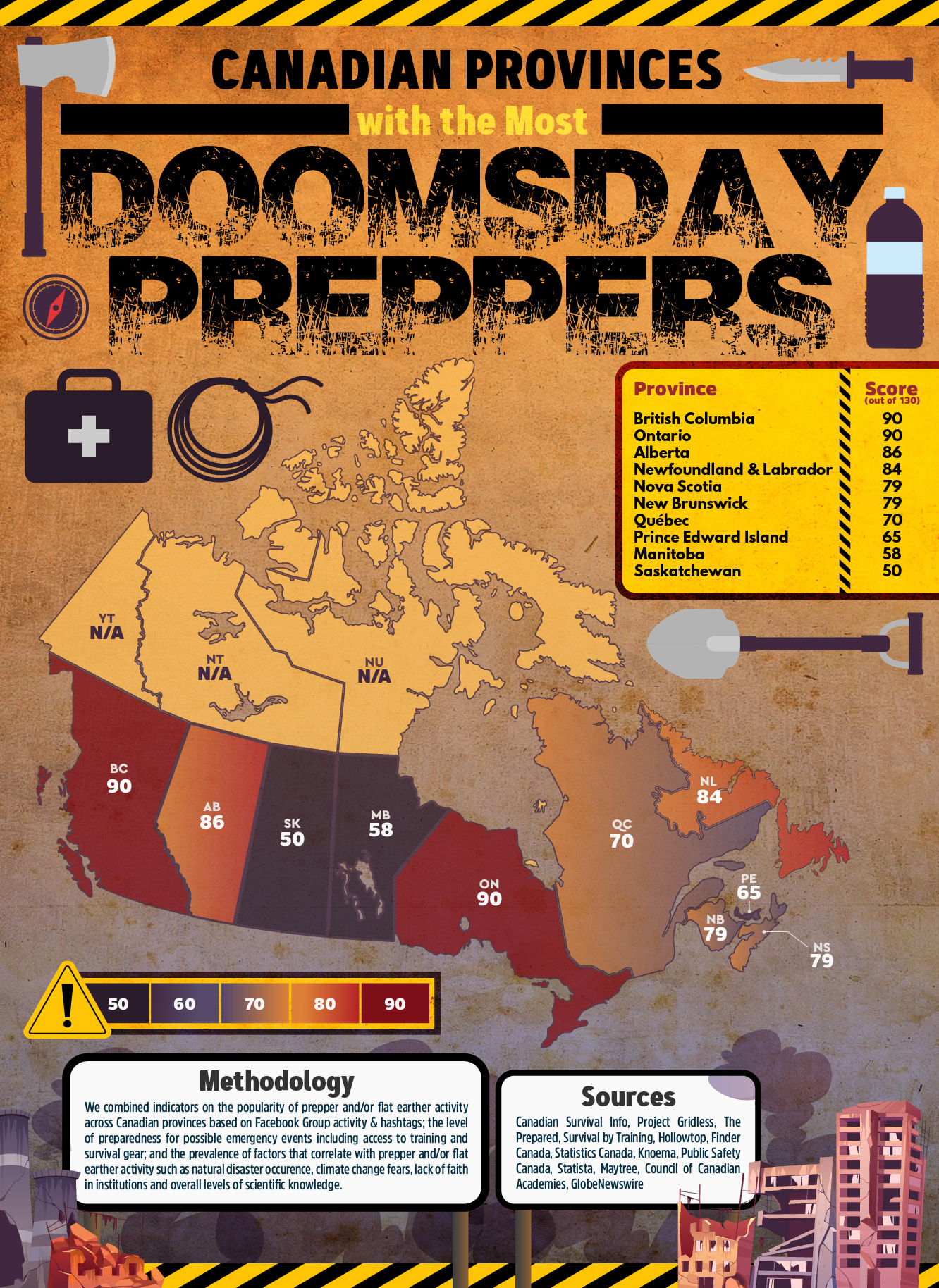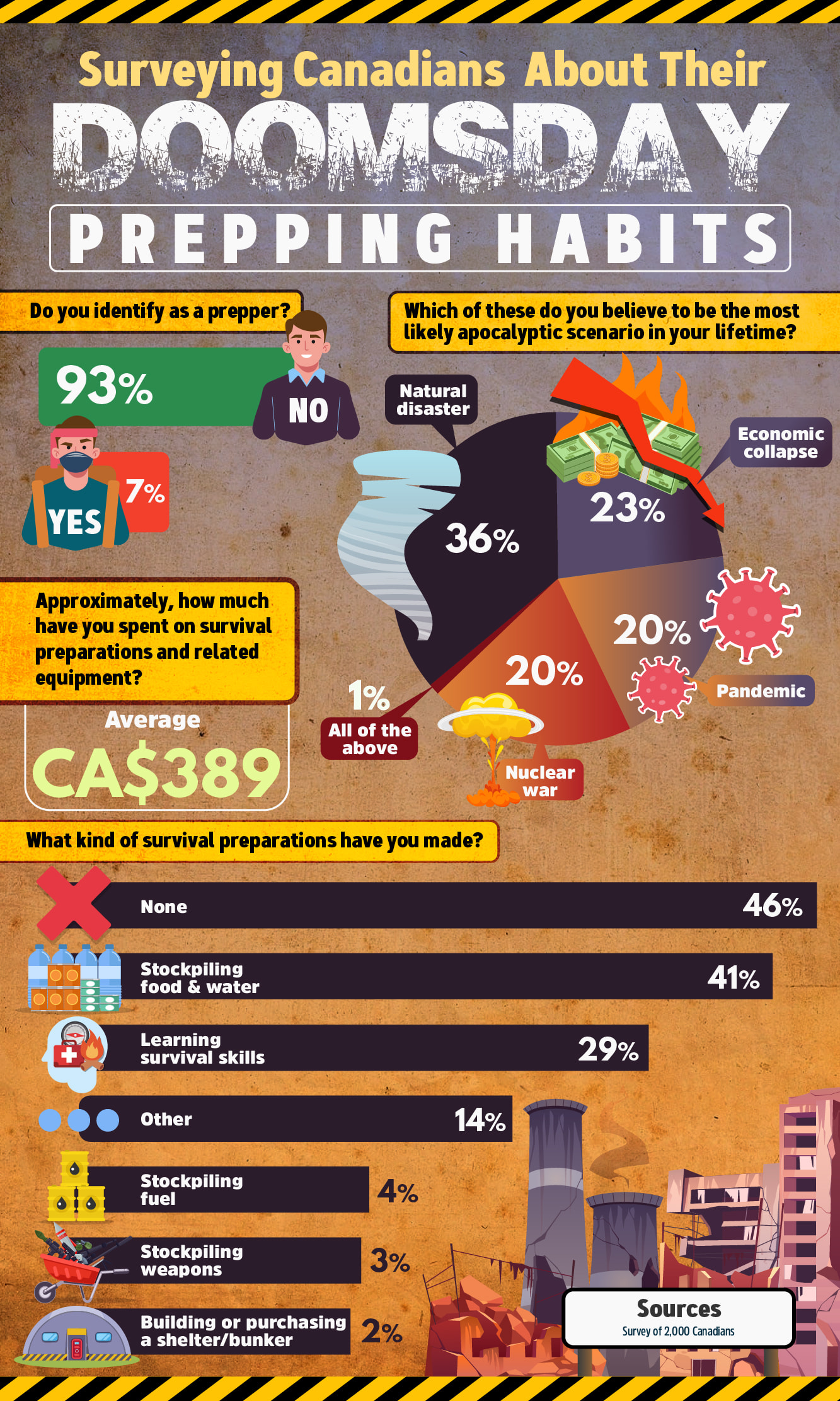Over 40% of the people in Nebraska, Maine, and Arizona, and about half of the residents of both Ontario and British Columbia say that they’ve done something that would count as doomsday prep within the last 12 months. This includes stockpiling supplies, learning survival skills, and creating emergency plans.
To see how the rest of the U.S. and Canada feels about the apocalypse, we conducted a survey of 5,000 residents (3,000 from the U.S. and 2,000 from Canada). We also analyzed online tendencies in the two countries via hashtags and Facebook groups to see what we could uncover about the general attitude toward the end of life as we know it. Here’s what we found.
Key Takeaways
- More than 56% of Americans and Canadians have done something to prep for doomsday in the past 12 months
- Most Americans and Canadians believe that a natural disaster is most likely to cause an apocalyptic scenario in their lifetime
- Only 2% of Americans and Canadians feel fully prepared for a doomsday event
- The average person in the U.S. and Canada spends just $441 preparing for an apocalypse
Nebraska Leads the Doomsday Charge
Just under half of all residents in Nebraska report that they’ve prepared for the apocalypse in the last year. And they’re not alone—Maine, Arizona, and Mississippi all come in at over 30%.
Of the top 20 states that house the most doomsday-prepared residents, an average of around 20% of all residents have done something to prep for the worst in the past 12 months, based on our survey alone.
Behind the top four states—Nebraska, Maine, Arizona, and Mississippi—are the following, along with the percentage of residents who fear the worst in each state.
- Missouri: 27%
- Arkansas: 25%
- North Carolina: 18%
- Florida: 17%
- Illinois: 16%
- Maryland: 15%
- Michigan: 15%
- Colorado: 14%
- Massachusetts: 14%
- Tennessee: 14%
- Virginia: 13%
- Wisconsin: 12%
- Georgia: 11%
- Louisiana: 11%
- Alabama: 10%
- Kentucky: 10%
We noticed that the urge to prepare for the worst isn’t just reserved for coastal states, states where seismic activity is an issue, or states in Tornado Alley. There seems to be a universal fear that things might not be as pleasant and comfortable in the near future as they are today.
Despite around 20% of the residents in these states taking action to prepare, only 9% of all Americans identified as preppers. To be fair, though, most people who have prepped have spent under $500 doing so, and the majority of them have done things like stockpile food and water and learn survival skills.
That’s a far cry from building a bomb shelter, but still…it suggests that a good portion of Americans are worried about the future.
B.C. and Ontario: The Best at Preparing for the Worst
A little further north, British Columbia and Ontario are Canada’s two twitchiest provinces. Both provinces score 90 out of 130 on our custom doomsday prepper metric, making them the places with the highest concentration of people who are seriously concerned about the apocalypse happening sometime next week.

A surprising 51% of British Columbia residents say that they’ve done some type of doomsday prep in the last 12 months—more than the residents of any single U.S. state. A whopping 12,000 people are also members of at least one B.C.-based prepper Facebook group, well above the overall average of 5,000 for Canada as a whole.
B.C. residents spend $792 per year on preparedness, which isn’t much but also isn’t nothing—and it’s nearly twice what U.S. residents have spent. A relatively modest 14% of British Columbians are campers. Now, camping with your car and a cooler full of beer might not help you survive the apocalypse, but we’re sure at least some of those 14% have learned useful skills while they’re enjoying the great outdoors…or, at least, they believe they have.
Ontario’s residents share some common ground with their West Coast brethren, at least when it comes to preparing for the worst. Responders from Ontario say they spend $1,342 per year on survival gear, which puts them ahead of British Columbians by a decent margin. However, just 8% of people from Ontario consider themselves campers; we’ll say those two stats cancel each other out.
A respectable 50% of Ontario residents also say they’ve done some doomsday prep within the last year, which is just one meager percentage point behind people from British Columbia. To make up for it, Ontario residents are more likely to be active in their online prepper communities, with 18,000 people belonging to one or more apocalypse-related Facebook groups.
Earthquakes and Viruses and A-bombs, Oh My
Out of all the apocalyptic scenarios we asked about, natural disasters are the most concerning to Americans and Canadians. A solid 40% of responders say that they think a natural disaster could create an apocalyptic scenario in their lifetime. We don’t know about you, but that seems like a lot.

An equally surprising 12% of Americans and 18% of Canadians say that they think nuclear war could cause the end of days before they kick the bucket. This is nothing compared to the nearly 100% of the population who were worried about nuclear winter during the Cold War, but it still seems fairly high.
An end-of-the-world pandemic is only a major concern for 20% of Americans and Canadians, which is surprising for the opposite reason, given how fresh the year we lost to COVID-19 is in many people’s minds.
An enlightened 1% of responders take the sensible approach and rank all of the above as the most likely apocalyptic scenario to occur during their lifetime. We may be laughing now, but just wait until a new super bug gets dispersed by a nuclear weapon during a major recession.
On a more serious note, the fact that some people believe they may live to see more than one world-ending catastrophe is more than a bit concerning. Fears of the apocalypse are as old as humanity itself, but we can’t help but think that the last few years have made people a little more sensitive to the idea that world-changing events are becoming more common.
Even with all of that said, only 64% of Americans and 54% of Canadians say they’ve done something that qualifies as prepping. Out of those percentages, 61% and 48%, respectively, say all they’ve done is stockpile food and water. Only 1% of Americans and 3% of Canadians feel they are fully prepared for an apocalyptic event.
It Ain’t Over ‘Til It’s Over
While doomsday prepping seems like it’s taking over as news outlets and articles online highlight the most out-there preppers, the reality is that only 9% of Americans and 7% of Canadians identify themselves as preppers. Sure, most people have done some type of doomsday preparation within the last year, but there’s a big difference between making sure the generator has gas and stockpiling guns and ammo in an underground bunker.
Whether or not you think doomsday prepping is a good idea or an overreaction, the bottom line is that people in parts of North America are afraid of the apocalypse. Government confidence is dwindling, while fears of climate change and economic collapse are on the rise.
You probably don’t need to start filling water bottles with gas or breaking ground on a new bunker, but you might want to have a little extra canned soup on hand…just in case.
Methodology
We reviewed social media trends related to prepping across the U.S. and Canada to discover which communities take their doomsday readiness most seriously. We looked specifically at trends related to the terms “prepper” and “flat-earther” based on Facebook Group activity and hashtags. Additionally, we looked at the level of preparedness in each province, along with natural disaster occurrence, fears related to climate change, lack of faith in institutions, and levels of scientific knowledge.
We also conducted a survey of 3,000 Americans and 2,000 Canadians in December 2023 to determine the states and provinces with the most self-identified preppers. The median age of the respondents was 35; 44% were male, 55% were female, and 1% identified as non-binary.
Fair Use
Our content and visuals can be shared for non-commercial use. If you use our content, please include a link back to this page to acknowledge our original research, writing, and image production.
